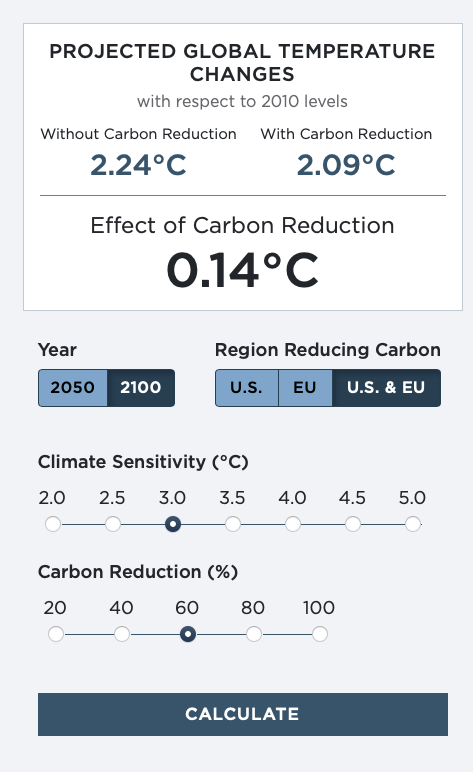According to the IPCC’s own calculations, if the U.S. and Europe cut carbon emissions by 60 per cent by 2100, the temperature increase averted would be a tenth of a degree Celsius, while costing $275 trillion by 2050. Try the calculator for yourself and then decide if Net-Zero by 2050 is worth it.
By John Robson, Climate Discussion Nexus, June 18, 2025
Every little bit helps when we face a climate crisis. And if you want to know what the benefit will be from cutting carbon emissions by our bit, or yours, the good people at the Heritage Foundation have the answer.
The foundation took an IPCC climate model called MAGICC (Model for Assessment of Greenhouse Gas Induced Climate Change) and created a Climate Change Calculator that lets you compute how much warming will supposedly happen by 2050 and 2100 (assuming we follow the “moderate” RCP6 scenario), and how much will be prevented by severe cuts in emissions by the United States and the European Union.
Crunching the numbers could be a great way to motivate people around you to join the efforts to prevent climate change! Or not, once they see how tiny the effects are by the alarmists’ own calculations.
For instance, if we assume climate sensitivity to a doubling of atmospheric CO2 is a 3°C temperature increase (which would be high), and that the U.S. cuts its emissions right away by 40 percent (huge), by the year 2100 global warming will have been reduced by… 0.06°C. Not so huge.
As another example, image below shows what reducing carbon emissions in the U.S. and Europe (a very large area of advanced economies!) by 60 per cent (which is basically a demolished fossil-fuel economy for both regions) by the year 2100 if the climate sensitivity is 3.0°C for a doubling of CO2.

The answer: 0.14°C, or ¼ of a degree Fahrenheit (0.25°F), which is not noticeable by the human body.1 To achieve this tiny reduction, we will have spent something like $275 trillion globally by 2050, according to the McKinsey Global Institute report “The net-zero transition: What it would cost, what it could bring.” Canada’s share of this will be $2 trillion, or about $80 billion a year, according to Prime Minister Mark Carney’s webpage before the recent election. Curiously, this figure seems to have disappeared from his Liberal webpage post-election.
The calculator only includes the U.S. and EU because most of the still-developing economies, like China and India, are not covered by the Paris Climate Agreement of 2015 and will continue to emit tonnes of carbon for decades to come, wiping out in a few weeks any “gains” from the efforts of the U.S. and Europe.
So give the calculator a try and see if you think reducing the global temperature by a fraction of a degree (not even a full degree!) is worth the pain of Net Zero by 2050.
- Battistel, Laura, et al., “An investigation on humans’ sensitivity to environmental temperature.” Nature: Scientific Reports, 13, Dec. 21, 2023. This article suggests the human body’s Just Noticeable Difference is between 0.38°C and 0.95°C, depending on conditions. [↩]
